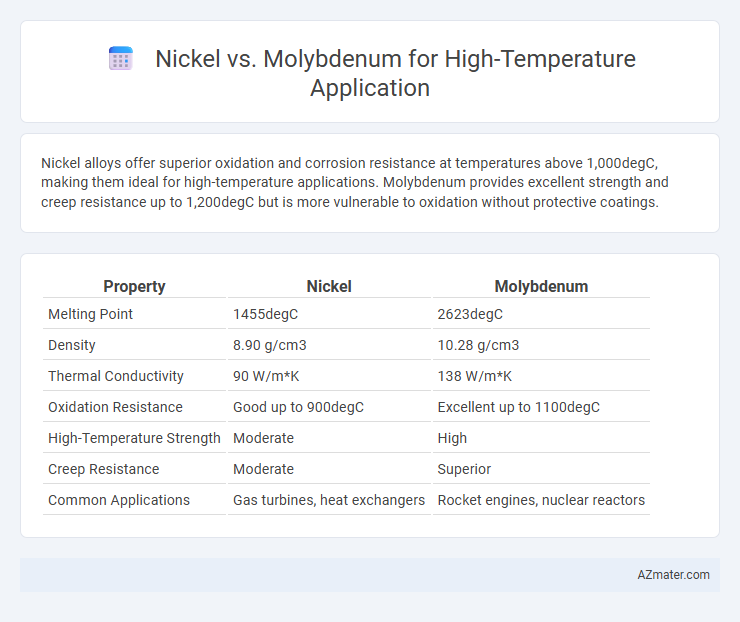Nickel alloys offer superior oxidation and corrosion resistance at temperatures above 1,000degC, making them ideal for high-temperature applications. Molybdenum provides excellent strength and creep resistance up to 1,200degC but is more vulnerable to oxidation without protective coatings.
Table of Comparison
| Property | Nickel | Molybdenum |
|---|---|---|
| Melting Point | 1455degC | 2623degC |
| Density | 8.90 g/cm3 | 10.28 g/cm3 |
| Thermal Conductivity | 90 W/m*K | 138 W/m*K |
| Oxidation Resistance | Good up to 900degC | Excellent up to 1100degC |
| High-Temperature Strength | Moderate | High |
| Creep Resistance | Moderate | Superior |
| Common Applications | Gas turbines, heat exchangers | Rocket engines, nuclear reactors |
Introduction to High-Temperature Materials
Nickel and molybdenum are critical high-temperature materials used for their exceptional thermal stability and corrosion resistance in extreme environments. Nickel alloys offer superior oxidation resistance and mechanical strength at temperatures above 1000degC, making them ideal for gas turbines and aerospace applications. Molybdenum, with its high melting point (2623degC) and excellent creep resistance, is preferred for furnace components and chemical processing equipment requiring both thermal endurance and structural integrity.
Overview of Nickel and Molybdenum
Nickel stands out for its exceptional oxidation resistance and stability in high-temperature environments, making it ideal for applications involving extreme heat such as gas turbines and chemical processing. Molybdenum offers superior strength and creep resistance at elevated temperatures, with excellent thermal conductivity and corrosion resistance, often used in aerospace and nuclear reactors. Both elements enhance alloy performance but nickel excels in corrosion resistance while molybdenum provides higher mechanical strength at elevated temperatures.
Thermal Stability: Nickel vs Molybdenum
Nickel exhibits superior thermal stability in high-temperature applications due to its ability to form a protective oxide layer that resists oxidation and maintains strength at elevated temperatures. In contrast, molybdenum offers excellent high-temperature strength but is prone to rapid oxidation above 600degC, limiting its use in oxidizing environments without protective coatings. The choice between nickel and molybdenum hinges on balancing oxidation resistance and mechanical performance under thermal stress.
Oxidation Resistance in Extreme Heat
Nickel exhibits superior oxidation resistance at high temperatures due to its ability to form a stable, protective oxide layer that prevents further deterioration in extreme heat environments. Molybdenum, while having excellent high melting points and mechanical strength, tends to oxidize rapidly, forming volatile oxides that degrade its structural integrity under prolonged exposure to extreme heat. Nickel-based alloys are therefore preferred for applications requiring enhanced oxidation resistance in high-temperature settings like gas turbines and heat exchangers.
Mechanical Strength at Elevated Temperatures
Nickel alloys exhibit superior mechanical strength at elevated temperatures, maintaining excellent creep resistance and tensile strength up to 1000degC, making them ideal for high-temperature applications such as aerospace and power plants. Molybdenum, while possessing high melting points and good strength retention, tends to oxidize rapidly at temperatures above 600degC, limiting its use in oxidizing environments despite its high thermal conductivity. For applications demanding sustained mechanical performance under extreme heat and oxidative conditions, nickel-based alloys outperform molybdenum due to their enhanced oxidation resistance and mechanical stability.
Corrosion Resistance Comparison
Nickel exhibits superior corrosion resistance in oxidizing environments at high temperatures due to the formation of a stable, protective oxide layer, making it ideal for applications in chemical processing and aerospace industries. Molybdenum offers excellent resistance to pitting and crevice corrosion in reducing and chloride-rich environments, enhancing durability in petrochemical and marine high-temperature settings. The choice between nickel and molybdenum depends on the specific corrosive agents present, temperature range, and desired mechanical properties for the high-temperature application.
Cost Efficiency and Availability
Nickel alloys are widely preferred in high-temperature applications due to their excellent oxidation resistance and mechanical strength, though their higher cost can impact budget-sensitive projects. Molybdenum offers superior strength at elevated temperatures with better cost efficiency, especially where high thermal conductivity and low coefficient of thermal expansion are required. Availability of nickel is generally more consistent globally due to larger production volumes, whereas molybdenum's supply may be subject to more regional fluctuations affecting procurement and pricing.
Common Industrial Applications
Nickel alloys are extensively used in high-temperature industrial applications like gas turbines, jet engines, and chemical processing due to their exceptional oxidation resistance and strength at elevated temperatures. Molybdenum, often alloyed or used as a coating, excels in environments requiring high melting points and resistance to thermal creep, making it vital in furnace components and nuclear reactors. Both metals are critical in the aerospace, power generation, and petrochemical industries, where maintaining material integrity under thermal stress is essential.
Environmental Impact and Sustainability
Nickel and molybdenum are critical metals for high-temperature applications, with nickel often sourced from sulfide ores that raise environmental concerns due to sulfur dioxide emissions, whereas molybdenum is primarily obtained as a byproduct of copper mining, potentially reducing the environmental footprint. Molybdenum's lower toxicity and greater abundance contribute to its sustainability advantage over nickel, which faces supply chain challenges and higher energy consumption in refining processes. Advances in recycling both metals are crucial for minimizing environmental impact and promoting sustainable industrial use in high-temperature environments.
Choosing the Right Metal for Your Application
Nickel exhibits excellent oxidation resistance and maintains strength at temperatures up to 1000degC, making it ideal for high-temperature applications requiring corrosion resistance and durability. Molybdenum offers superior thermal conductivity and stability at temperatures above 1000degC, with a melting point of 2623degC, suitable for environments demanding high strength and minimal thermal expansion. Selecting between nickel and molybdenum depends on operating temperature range, corrosion resistance needs, and mechanical stress factors in your application.

Infographic: Nickel vs Molybdenum for High-temperature application
 azmater.com
azmater.com